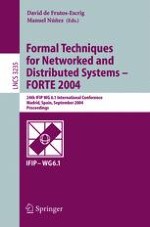2004 | Book
Formal Techniques for Networked and Distributed Systems – FORTE 2004
24th IFIP WG 6.1 International Conference, Madrid Spain, September 27-30, 2004. Proceedings
Editors: David de Frutos-Escrig, Manuel Núñez
Publisher: Springer Berlin Heidelberg
Book Series : Lecture Notes in Computer Science
Included in: Professional Book Archive
